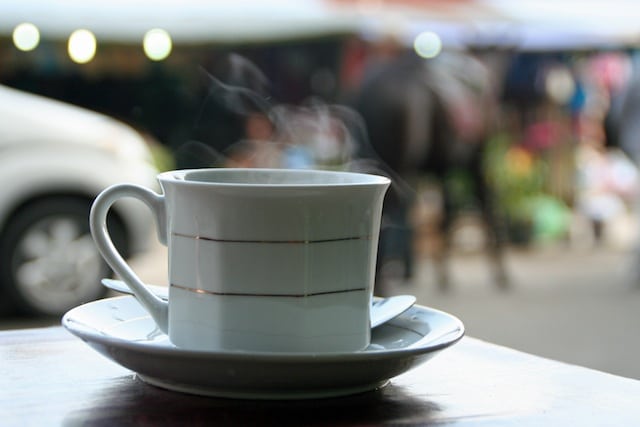
In this article, Epicure & Culture
While Chinatowns are a growing staple for any major city, the large Chinese influence in Singapore makes its version particularly lively and impressive. It hosts a seemingly endless array of shops and restaurants overlooking the famous Buddha Tooth Relic Temple and is brimming with tourists and locals alike every day (and night) of the week. While these headlining attractions pull in large numbers of visitors, I instead take a step back in time and head for a smaller site nestled on the crowded corner of Keong Saik Road across from the old-time Hotel 1929: the Tong Ah Eating House. This small shop continues the street’s the busy 1920s theme as I attempt to manoeuvre my way past a large group of older women seated on brightly colored plastic chairs enticed in their weekly gossip. Finally making it past the group, I approach the window counter and ask for a regular coffee. The shop lady pulls a face for a brief instant, then relies with “kopi-c, can” and proceeds to draw up the brew. After taking a few moments to sock-filter some margarine-roasted coffee beans, I was faced with a messy, but nonetheless delicious cup of traditional kopitiam coffee.
For the most part, Singapore is a city that has been rushing fearlessly into the future, with several islands and 700,000 new housing developments set to be constructed by 2030. As a result, it holds a significantly higher standard and cost of living than many of its Southeast Asian neighbors. However, one aspect of the nation that has held onto old-time tradition despite this rush forward is its kopitiam culture (where “kopi” translates as the Malay word for “coffee” and “tiam” translates as the Hokkein word for “shop”). Even just the word “kopitiam” and its multilingual translation reflect Singapore’s diverse cultural history.
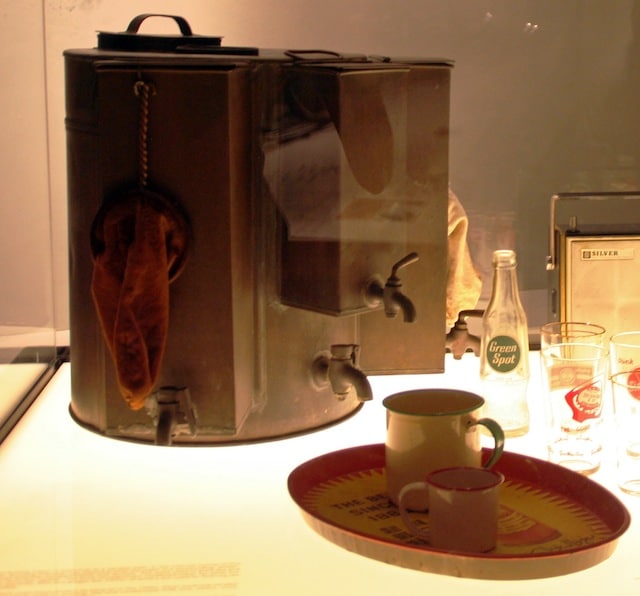
History Of Kopitiam Coffee
It’s not only the word that holds unique chronicling, the history of these shops hold an unrivalled past. It begins in the late 18th century, when Singapore initiated a flood of immigrants from across Europe and Asia in order to help speed up the country’s development. When these cultures began to co-mingle, the European love of coffee met Malaysian taste buds and kopi was born. This brew didn’t only get a new name; it also re-vamped the entire coffee production process. First up, strong, bitter Robusta beans were substituted in for the traditional Arabica variety due to their better adaptability to South East Asian growing conditions. Next, as many of Singapore’s new immigrants did not have access to traditional brewing appliances, a new sock filter was introduced. This filtering process involves coating the inside of a flannel “sock” with ground coffee beans, placing it over a coffee cup, pouring in some hot water and allowing it to filter through. The beans coat the flannel material, allowing the water to steep and absorb the coffee flavor. Finally, adding sugar and evaporated milk completes the process and the result is a thick, sweet coffee.
Since work for Singapore’s new residents was hard and hours were long, laborers needed a place to socialize and unwind, and kopitiams became the perfect location to fill this charge. They were a place for people of all cultures, religions and social standings to come together, discuss daily happenings, play a game of chess and, of course, enjoy a cup of kopi.
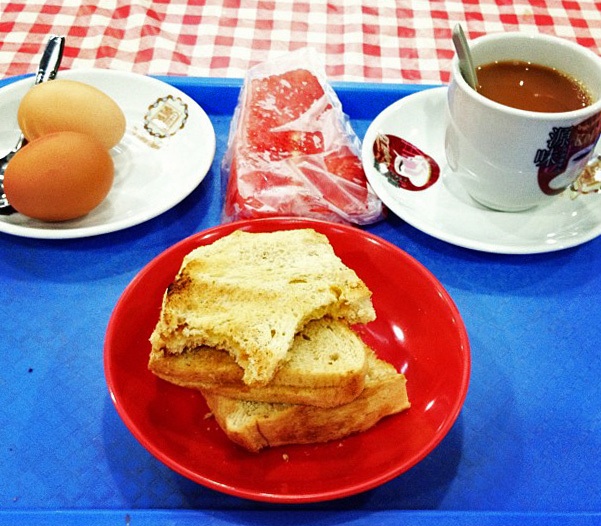
The Culinary Side Of The Kopitiam
Eventually, the shops expanded to include not only drinks, but a selection of food as well. Options varied depending on the operator’s background but were inclusive to the needs of a wide clientele base. For example, it wasn’t uncommon to see a Hokkein kopitiam serving Halal meat. In true Singaporean style, an eventual staple fusion emerged in an eastern adaptation of a western breakfast. This consisted of the traditional toast and eggs combinations, but topped the toast with kaya jam and served the eggs at a runny, soft-boiled consistency. This kaya jam is a type of curd that Chinese ship workers began serving to Europeans on boats heading to Singapore when traditional jam supplies began to fall through. It consists of coconut, eggs, green pandan leaves (which give it its colour) and sugar. The recipe was such a hit that the Europeans continued to request it once arriving in Singapore and the Chinese took to making it for their own consumption as well in their kopitiams.
A Dark Turn
While kopi and a chess board were all most people needed at their local hang-out, when Singaporean gambling farms became outlawed in 1829, some kopitiams became a front to house illegal samseng (gangster) and gambling activities. As a matter of fact, this is how Tong Ah got its start and continued to operate until the 1960s. During this time, false walls hid the entrance to a back room, which was set up for gang meetings around mahjong tables.
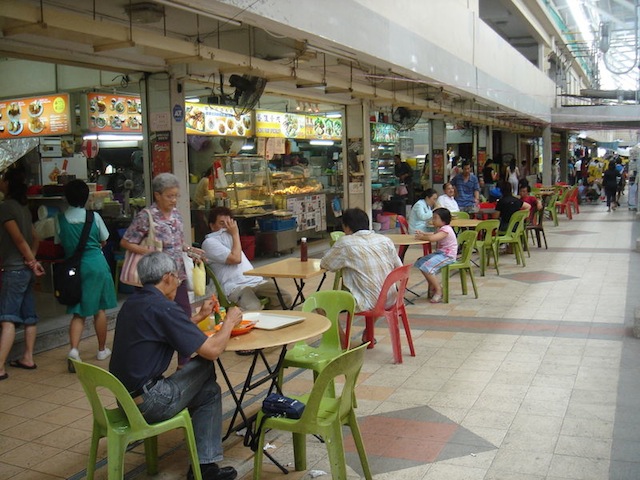
Back To Their Roots
Eventually, gambling became re-legalized in Singapore and kopitiams went back to serving kopi as their main feature. Instead of catering to samseng, they shifted their targets to the general population. This proved to be an easy transition as during the 1950s, the Singapore Housing Development Board (HDB) began building large affordable residential complexes, which provided perfect locations for kopitiams to set up shop. During this era, songbird breeding was a popular pastime and many patrons would bring their birds with them while they enjoyed their morning brew. Friendly banter would mix with melodious singing, creating a cheery mood, deeply contrasting the darker, samseng image these shops previously held.
Kopitiams Today
As I sit in the present day Tong Ah, I encounter neither gangsters and songbirds, nor the newer, sleeker Singapore. While food standards have increased significantly over the past 60 years, kopitiams like Tong Ah have refined the sock filter into a sophisticated device and turned slicing the perfect piece of toast and boiling an egg to a perfectly soft consistency into an art, with many kopitiam “artists” searching for the elusive perfect breakfast composition in order to compete with larger chains. Despite this, more and more tiams have been closing down in recent years due to this steep competition and rising labor costs. While kopitiams used to run in a single family for generations, fewer young adults are choosing to follow in their parents’ footsteps due to the lowbrow label they’re often associated with. In addition, no Singaporean business is allowed to employ a foreign worker (who does not have permanent residence in Singapore) before it hires nine Singaporean workers due to new labor laws. This has been a struggle for kopitiam owners who often find Singaporean workers to be less willing and committed to work the long hours required in these positions.
Sipping on a simple cop of kopi and watching the outside world go by, it’s easy to forget about the long and complex history of the drink’s life in Singapore. The contrasting taste and friendly simplicity are perhaps what makes the beverage so appealing, despite whatever changes may be occurring in the country, one thing that remains certain is the fact that you will always be able to find a good cup of coffee and some comforting toast and eggs at a local tiam.
How To Order Traditional Kopitiam Coffee
If you want to experience some of this kopitiam culture for yourself, don’t be surprised if an English menu is lacking. The country’s popular “Singlish” slang covers a whole array of coffee-themed terms. Here’s a list of common orders:
Kopi: the most popular mix of coffee with sweetened condensed milk
Kopi Gau: a strong brew of coffee
Kopi Poh: a weak brew of coffee
Kopi Kosong: substitutes condensed for evaporated milk
Kopi-C: coffee with evaporated milk and sugar (most similar to a “regular” western coffee)
Kopi-O: coffee with sugar but no milk
Kopi Peng: iced coffee
These terms can then be combined together. For example, a strong iced coffee with evaporated milk and sugar would be called “kopi-c gau peng.”
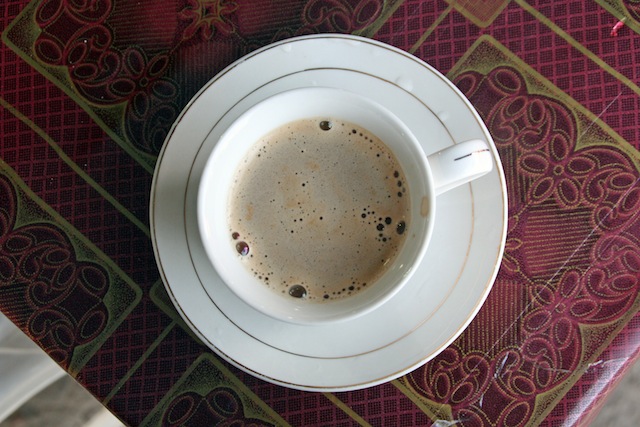
Top Kopitiams In Singapore
Tong Ah Eating House
Location: 36 Keong Saik Road, Singapore
Phone Number: (65) 6223 5083
Kopitiam
(Multiple locations across Singapore)
Phone Number: (65) 6333 3344
Killiney Kopitiam
(Multiple locations across Singapore)
Phone Number: (65) 6291 2668
Contributed post by Judi Zienchuk.

Jessica Festa is the editor of the travel sites Jessie on a Journey (http://jessieonajourney.com) and Epicure & Culture (http://epicureandculture.com). Along with blogging at We Blog The World, her byline has appeared in publications like Huffington Post, Gadling, Fodor’s, Travel + Escape, Matador, Viator, The Culture-Ist and many others. After getting her BA/MA in Communication from the State University of New York at Albany, she realized she wasn’t really to stop backpacking and made travel her full time job. Some of her most memorable experiences include studying abroad in Sydney, teaching English in Thailand, doing orphanage work in Ghana, hiking her way through South America and traveling solo through Europe. She has a passion for backpacking, adventure, hiking, wine and getting off the beaten path.








